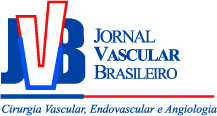O papel da oxigenação hiperbárica na estrutura do fígado e baço após ligadura das veias hepáticas: estudo em ratos
The role of hyperbaric oxygenation in the liver and spleen structure after hepatic vein ligation: study in rats
Ricardo Costa-Val; Tarcizo Afonso Nunes; Roberto Carlos de Oliveira e Silva
Resumo
Palavras-chave
Abstract
Keywords
References
Sherlock S. O sistema venoso porta e hipertensão porta. Doenças do fígado e do sistema biliar. 1991:109-58.
Johansen KH. Portal hypertension. Decision making in vascular surgery. 2001:306-10.
Bhasin DK, Malhi NJS. Variceal bleeding and portal hypertension: much to learn, much to explore. Endoscopy. 2002;34:119-28.
Nunes TA, Miranda GHG. Quando indicar o tratamento cirúrgico da hemorragia digestiva alta?. Tópicos em gastroenterologia. 2003:279-92.
Valla DC. Hepatic vein thrombosis (Budd-Chiari syndrome). Semin Liver Dis.. 2002;22:5-14.
Janssen HL, Garcia-Pagan JC, Elias E. Budd-Chiari syndrome: a review by an expert panel. J Hepatol. 2003;38:364-71.
Xu PQ, Dang XW. Treatment of membranous Budd-Chiari syndrome: analysis of 480 cases. Hepatobiliary Pancreat Dis Int. 2004;3:73-6.
Menon KV, Shah V, Kamath PS. The Budd-Chiari syndrome. N Engl J Med. 2004;350:578-85.
Nylander G, Lewis D, Nordstom H, Larsson J. Reduction of postischemic edema with hyperbaric oxygen. Plast Reconstr Surg. 1985;76:596-603.
Edwards RJ, Im MJ, Hoopes JE. Effects of hyperbaric oxygen preservation on rat limb replantation: a preliminary report. Ann Plast Surg.. 1991;27:31-5.
Zamboni WA, Roth AC, Russell RC, Graham B, Suchy H, Kucan JO. Morphologic analysis of the microcirculation during reperfusion of ischemic skeletal muscle and the effect of hyperbaric oxygen. Plast Reconstr Surg. 1993;91:1110-23.
Zamboni WA. The microcirculation and ischemia-reperfusion: basic mechanisms of hyperbaric oxygen. Hyperbaric medicine practice. 1999:779-95.
Chen MF, Chen HM, Ueng SW, Shyr MH. Hyperbaric oxygen pretreatment attenuates reperfusion injury. Liver. 1998;18:110-6.
Chaudry IH, Wang P, Jarrar D. Ischemia and reperfusion injury. Vascular trauma. 2004:73-84.
Orloff MJ, Daily PO, Girard B. Treatment of Budd-Chiari syndrome due to inferior vena cava occlusion by combined portal and vena caval decompression. Am J Surg. 1992;163:137-42.
Ponce Gonzales JF, Dominguez Adame Lanuza E, Martin Zurita I, Morales Mendez S. Portal hypertensive colopathy: histologic appearance of the colonic mucosa. Hepatogastroenterology. 1998;45:40-3.
Grim PS, Gottlieb LJG, Boddie A, Batson E. Hyperbaric oxygen therapy. JAMA. 1990;263:2216-20.
Costa-Val R, Silva RCO, Nunes TA, Souza TKDP. O papel da oxigenoterapia hiperbárica na doença vascular periférica. J Vasc Br.. 2003;2:177-82.
Lima EB, Bernardes CHA, Martins ACG, Marcondes CM. O papel da oxigenoterapia hiperbárica no tratamento da gangrena gasosa clostridiana e da fasciite necrotizante. J Vasc Br. 2003;2:220-4.
Maffei FHA. Oxigenoterapia hiperbárica [editorial]. J Vasc Br. 2003;2:169.
Lyra Pereira ML, Teles AP, Pereira Neto J. Câmara hiperbárica de acrílico para animais de pequeno porte. Acta Cir Bras. 2001;16:267-70.
Angel MF, Ramasastry SS, Swartz WM, Narayanan K, Kuhns DB, Basford RE. The critical relationship between free radicals and degrees of ischemia: evidence for tissue intolerance of marginal perfusion. Plast Reconstr Surg. 1988;81:233-9.
Hammarlund C, Sundberg T. Hyperbaric oxygen reduced size of chronic leg ulcers: a randomized double-blind study. Plast Reconstr Surg. 1994;93:829-33.
Hammarlund C. The physiologic effects of hyperbaric oxygenation. Hyperbaric medicine practice. 1999:37-69.
Makhoul RG, Fields CF, Cassano AD. Nitric oxide and the vascular surgeon. J Vasc Surg. 1999:569-72.
Howe LM, Boothe DM, Slater MR, Boothe HW, Wilkie S. Nitric oxide generation in a rat model of acute portal hypertension. Am J Vasc Res. 2000;61(10).
Pereira MLL, Scheidt TC, Simoes MJ, Mosquette R, Gomes PO. Oxigenoterapia hiperbárica em lesões actínicas de colo de ratos: aspectos morfológicos e morfométricos. Acta Cir Bras. 2004;19:658-63.
Hartleb M, Michielsen PP, Dziurkowska-Marek A. The role of nitric oxide in portal hypertensive systemic and portal vascular pathology. Acta Gastroenterol Belg. 1997;60:222-32.
Moncada S, Higss EA. Endogenous nitric oxide: physiology, pathology and clinical relevance. Eur J Clin Invest. 1991;21:361-74.
Moncada S, Palmer RMJ, Higss EA. Nitric oxide: physiology, pathology and pharmacology. Pharmacol Rev. 1991;43:109-42.
Mazariegos GV, O'Toole K, Mieles LA, Dvorchik I, Meza M, Briassoulis G. Hyperbaric oxygen therapy for hepatic artery thrombosis after liver transplantation in children. Liver Transplant Surg. 1999;5:429-36.

